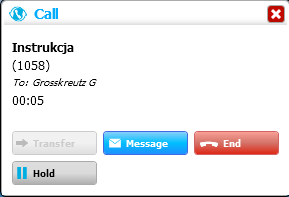Difference between revisions of "User:Grzegorzg"
m (→Call window) |
m (→Call window) |
||
| Line 212: | Line 212: | ||
|3 | |3 | ||
|| <center>[[File:PhoneCTI Połączony z.PNG]]</center> | || <center>[[File:PhoneCTI Połączony z.PNG]]</center> | ||
| − | || | + | ||Title visible after establishing call. |
|- | |- | ||
|4 | |4 | ||
Revision as of 13:43, 1 March 2013
Contents
Introduction
In following manual we are proud to present you Slican PhoneCTI application, which includes all functionalities enable to integrate phone and computer used by PBX subscriber. Main advantage of this software is integration of phone books stored in PBX and subscriber computer. In Slican PhoneCTI application, phone books stored in PBX are used, changes in phone books can be entered in PBX (from phone of from ConfigMAN application) or in computer (Slican PhoneCTI application). Any modification is immediately visible for other users, with appropriate privileges defined in PBX. Phone book editing rules defined in PBX are also valid for editing in Slican PhoneCTI. Additionally Slican PhoneCTI application includes internal chat functionality (computer user can be any PBX subscriber). Sending messages to other person from phone book, who is not PBX subscribers, is possible via XMPP account (if such account was defined for this person) or as SMS. Sending SMSes is also possible according privileges defined in PBX. Internal chat functionality can be attractive for companies, which use Slican PBX and don't allow , from security reasons, to use common chat, as well for person who use one application and want to communicate with persons who uses different chat applications.
Minimal requirements
To install SLICAN PhoneCTI application, following minimal requirements are necessarily:
- Computer should be powered with clock >800 MHz
- Computer RAM memory should be 1GB minimum
- Computer graphic card should be compatible with DirectX 9
- Operating system - WindowsXP SP2 or later
- Microsoft .NET Framework 4.0 or later should be installed on computer
- Web browser Internet Explorer 7 or later should be installed on computer
Installing application on computer which doesn't fulfill mentioned minimal requirements is possible but it will work slowly or not all functions will be active.
|
Installation
Slican PhoneCTI application is licensed and using it requires purchase of appropriate license code. Purchased license code is entered during PBX configuration and decides about number of workstations with Slican PhoneCTI application. Application licensing has no influence on its installation. Application setup can be downloaded from Slican webpage and application install on the computer by entering appropriate data, necessarily to log in, in tap Settings - Connection.
|
Second installation stage (not obliged) rely on uploading to PBX properly prepared file with PhoneCTI application update. It can be done by PBX admin. This activity, if done, enables automatic updating PhoneCTI application on workstations. Updating is described in chapter Application updating.
Application launch
PhoneCTI application can be launched as any other Windows application. In application settings you can activate functionality of automatic launching application after operating system start. Diuring launching application it log into PBX (according settings defined in tap Settings - Connection). After successful login, application synchonizes application data with appropriate data in PBX.
Application updating
Application updating id executed automatically and user has no influence on its proceedings. Similarly as for PBX, VoIP card or REC card firmware updating, updating of Slican PhoneCTI application updating is executed by PBX admin. Every time during PhoneCTI application launching version check (uploaded to PBX and installed on user PC) is carry out. If these version numbers are different, application stored in PBX is automatically downloaded and installed on user PC, next new installed application is launched and log into PBX. Depending on version number updating can be upgrading or downgrading.
Application structure
Designation rules
PhoneCTI application is very simple and intuitive, with help of appropriate icons status of phones visible in application windows. These icons invite user to execute specific action.
Icons and symbols
For PBX extension numbers, symbol of phone status and linked phoneCTI application consits of two icons, first of them represents phone status, while second represents application status. In Table 1 you can see icons represent phone status.
Table 1: Icons represent phone status.
In Table 2 you can see icon represents number, if number assigned to specified contact is external numer.
| Phone status | |
|---|---|
| Icon | Icon meaning |
| This icon means external number | |
Table 2: Icon represents external number
This icon is always blue, because in opposite to extension numbers status of such phone there is not monitored.
| Application status | |
|---|---|
| Icon | Icon meaning |
| <None> | If there in no icon for specified extension number, application PhoneCTI was never logged to specified extension number |
| This icon means, that application is launched and logged to epecific extension number | |
| This icon means, that application is in status "Be Right Back", application enter such mode after time of inactivity defined in settings | |
| This icon means, that application found out DND phone status (do not disturb)[1] | |
Table 3: Icons represent application status.
Finally symbol of phone and application linked with this phone is created by merging one icon from Table 1 with one icon from Table 2.
Example
For illustrate mentioned above rule three such symbols was presented in below table:
Table 4: Examples of symbols used by application
Symbols location and meaning
Symbols presented in "Table 4 can be visible in two places. After log in appropriate symbol is visible in top part of PhoneCTI application window, as it is presented on following figure:
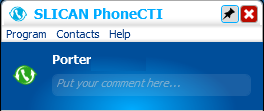
Additionally on contact list in all instances of PhoneCTI this symbol is visible near comment defined for specific extension number:
Also following information should be noticed:
- Below extension number comment defined in PBX, there is description defined individually by PhoneCTI user. Of course this description is optional and if itb isn't defined, in top part of window following text is visible: "Put your comment here..." - this text prompts you to enter individual description, on contact list individual description isn't displayed.
- If specified contact includes extension number, this number is visible on the right side of comment.
- If specified contact is included in public phone book and for this number option "Restrict" is switched on, only text "Restricted" appears on screen and read this number is impossible.
- Icons located on right side of contact have following meaning:
-
- contact includes extension number with logged PhoneCTI application or logged XMPP account, so there is possible to send text message to computer assigned to this number, sent text message will be immediately displayed on computer screen.
-
- contact includes extension number or XMPP account and both - PhoneCTI application nor XMPP account are not logged, there is possible to send text message to computer assigned to this number, sent text message will be displayed on computer screen immediately after log in PhoneCTI application or XMPP account.
-
- contact contains number defined in public or private phone book (such contact is marked as
icon on its left side), not includes extension number nor XMPP account and PhoneCTI application never been logged to contact's extension number - if any, so there is possible to send only SMS message to this number
-
- such icon means, that specified contact is not included in Favourites. Clicking this icon add it into Favourites.
-
- such icon means, that specified contact is included in Favourites. Clicking this icon remove it from Favourites.
-
Settings
After selecting option Settings from Program menu, the Settings window appears on screen. There are some taps in this window, these taps can be used to set several application option. All taps are described in following chapters.
Settings - Connection
After selecting Connection tap, following window appears on the screen:
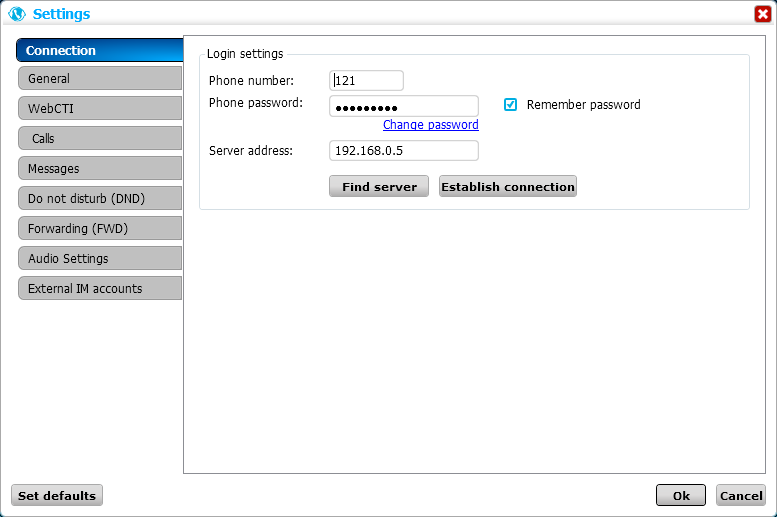
Window visible above includes fields which are necessarily to entering data required to establish connection with PBX. Into the first of these field, you should enter extension number of phone, which will be assigned to PhoneCTI application. Second field should contain password defined for subscriber with extension number is defined in previous field (Password can contain from 4 to 16 characters, excluding ";" and "~" characters). Password should be entered by PBX admin in ConfigMAN application (sheet Subscribers/CTI Settings). During first log in PhoneCTI application, application will force change of this password. Such change can be executed also in any time by clicking link Change password, which is located below the field with password. After clicking this link, following window will be visible on screen:
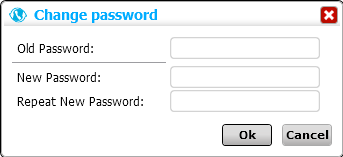
In this window you should enter old password and new password two times. If all data are entered correctly, password will be changed and stored in PBX configuration. Due to this functionality admin doesn't know the passwords of subscribers. Entered password can be remember in application, by check box located of the right side of field including password. If this check box is empty, application will be enquire password every time while log in. Next field in this window is designed for entering IP addres of PBX. This address can be entered manually or automatically after pressing button "Find server" and selecting appropriate PBX from list of PBXes visible in network. After pressing button "Establish connection", if all mentioned fields are correctly fulfiled, application will connect to the PBX and all data including phone book will be synchronized. After successful connection in bottom part of window, following text will be visible:
If entered data are incorrect, another text will be visible in bottom part of window:
Simultaneously link Change password changes to Forgot password, after clicking this link special WebCTI window opens, in this window is possible to send message with password to specified e-mail address.
Settings - General
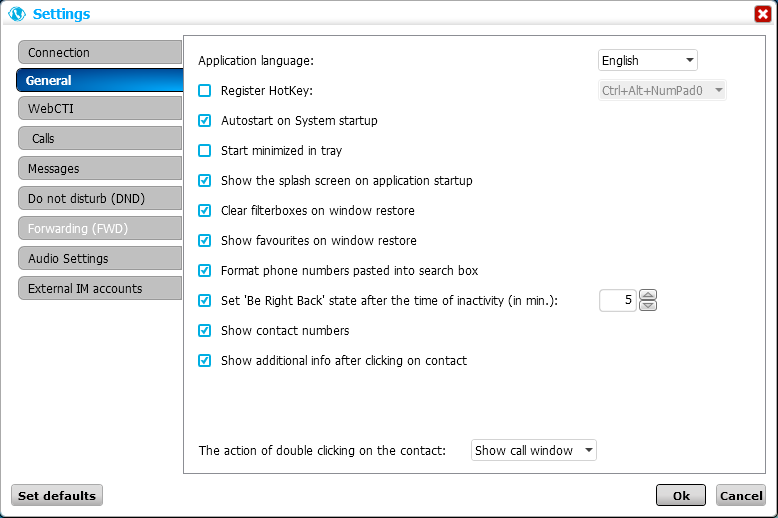

Show call window - after selecting this option, double click causes displaying following window on computer screen[2]

After clicking in - located in this window - button with green handset appropriate number will be dialed and connection established, call establishing process is different, depending phone type assigned to extension number, to which PhoneCTI application is logged. For system phone, PBX simulate to hang up the handset, dial appropriate number, after answering this call acoustic channel is switched on and you can talk. For analog phone, PBX dial appropriate number and after answering ring back to the extension, to which PhoneCTI application is logged.
Make call - after selecting this option, double click on specified contact causes ring to this contact and establish call according rules described above.
Show message window - after selecting this option, double click causes displaying window described in chapter 4.6.1 Message window.
Settings - WebCTI
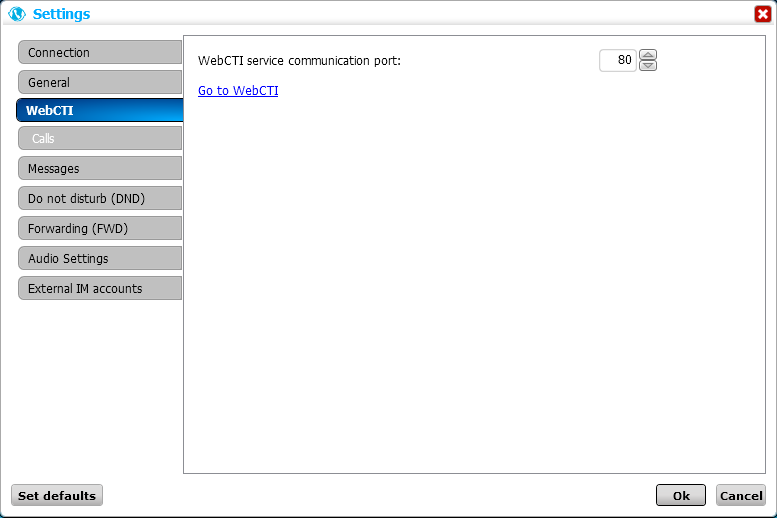
In this window, you can define port number used for listening recorded calls in WebCTI application. This settings is used only for remote registering (from outside local network). Additionally in this window there is link Go to WebCTI, after clicking this link, application WebCTI - stored in PBX - is launched.
Settings - Calls
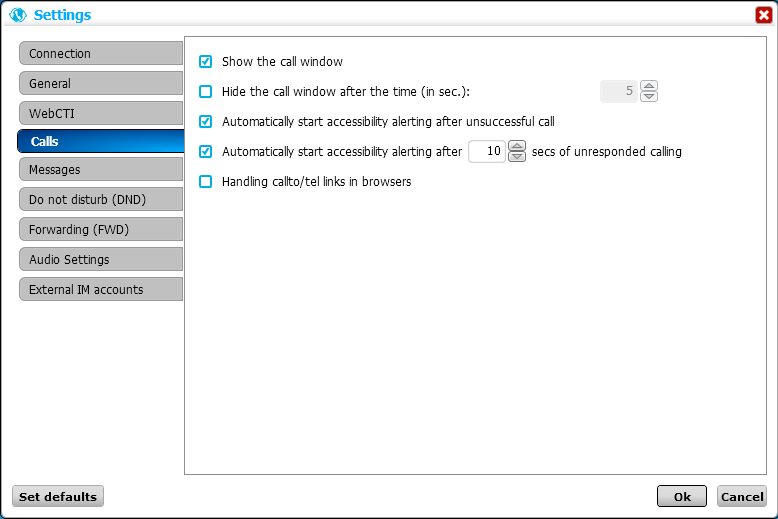
In this window you can define method of call signaling. After checking first option, while incoming call or lifting handset (for outgoing calls), on computer screen one of following windows appears (depending on call direction):
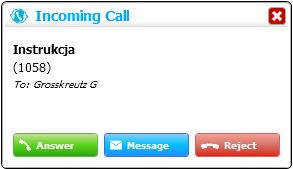
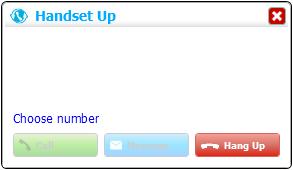
If second option is also checked, call window will close after specified time. Detailed description of call window is included in chapter 3.5.4 Call window. It is possible also to switch on an automatic notifications about accessibility of subscriber, if previously calll to his/her number was unanswered or number was busy. Such notification appear on computer screen if subscriber with previously dialed number make any action with phone. In lower right corner of computer screen following window appears:

Above window disappear after time defined in window 'Messages', but in tray there is an following icon:
It means notification from contact. After clicking this icon following window appears:
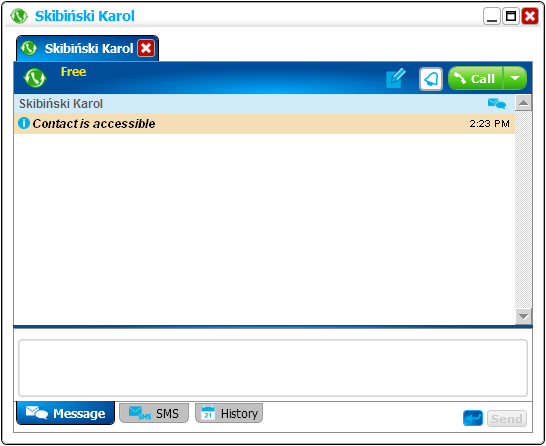
This message prompt to dial previously unavailable extension number.
Settings - Messages

After checking first field in this window, on computer with PhoneCTI application logged on extension number, following window will appear if any message will be send to this extension number:

Above window disappear after time defined in window 'Messages', but in tray there is an following icon:
After clicking in this envelope, window with message text appears on computer screen.
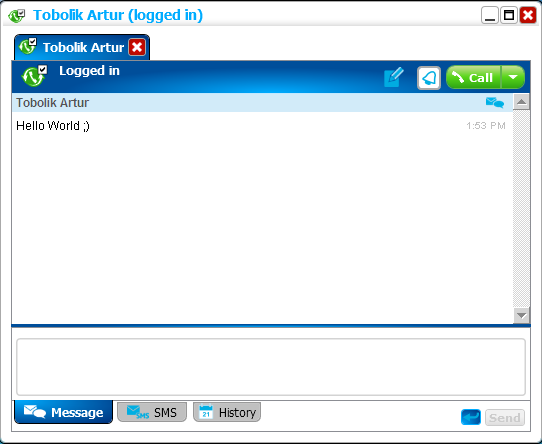
In this window all messages sent to and from specfied extension number during current day. Messages from previous days are stored in archive. If this filed is not checked, window of message notification do not appears. Detailed description of this window is included in chapter 4.6.1 Message window. In field "Message Validity" you can define time of storing SMS by mobile provider, if provider can't deliver it to recipient. During this time provider repeats SMS sending attempt. Last field defines if check of text entered into message will be executed. Language of dictionary used to checking is the same as application language.
Settings - Do not disturb (DND)
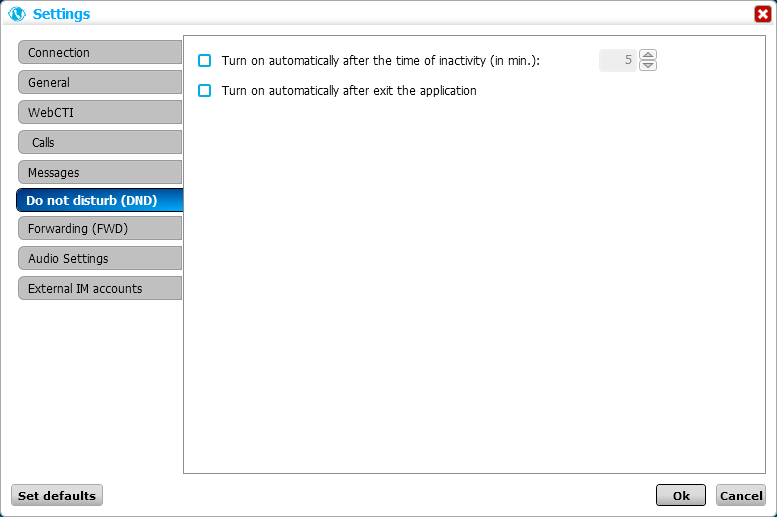
This screen is used to setting rules of switching on the DND service. Switchnig on this service is done after specified number of user idleness. Idleness status is when user doesn't use phone nor computer. It is also possible to set automatic switchnig on DND service after quiting application. Obwiously it is possible to switch on DND service in both situations. In the lower part of PhoneCTI main window there is small button, when you click this button DND service is switched on off (dependently on current ststus of this service) for extension number assigned to PhoneCTI application.
Settings - Forwarding (FWD)
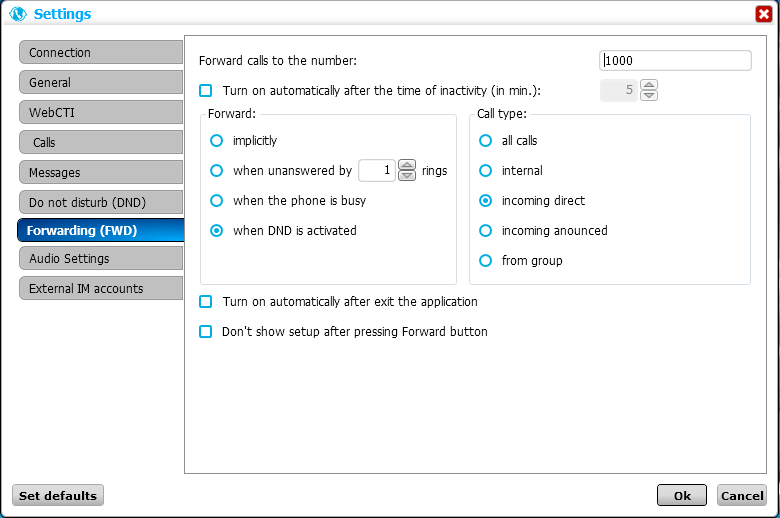
In this window there are located all settings decide about forwarding conditions for specified extension number. These settings can be also set in ConfigMAN application or from phone using appropriate services. Swithing on forwarding can take place after defined time of idleness. Idleness status is when user doesn't use phone nor computer. It is also possible to switch on forwarding after quiting application. Obwiously it is possible to switch on forwarding in both situations. While automatic switching on forwarding, it is realized according settings done in this window. By default after clicking button FWD located in the lower part of PhoneCTI main window above window is displayed on computer screen. After checking last field, above window is not displayed but forwarding is switched on according stored settings.
Settings - Audio settings
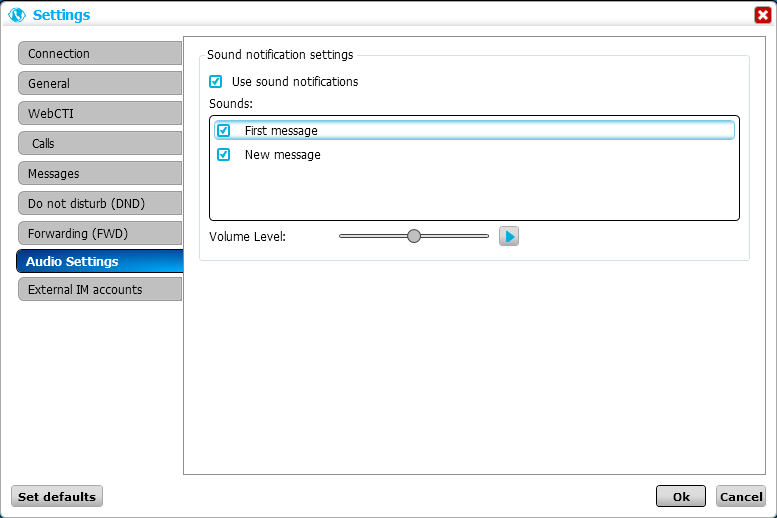
In this window you can define method of audio signaling an incoming message.
|
Phone book
Below figure presents phone book window, this window appear on computer screen after selecting option Book from menu Contacts.
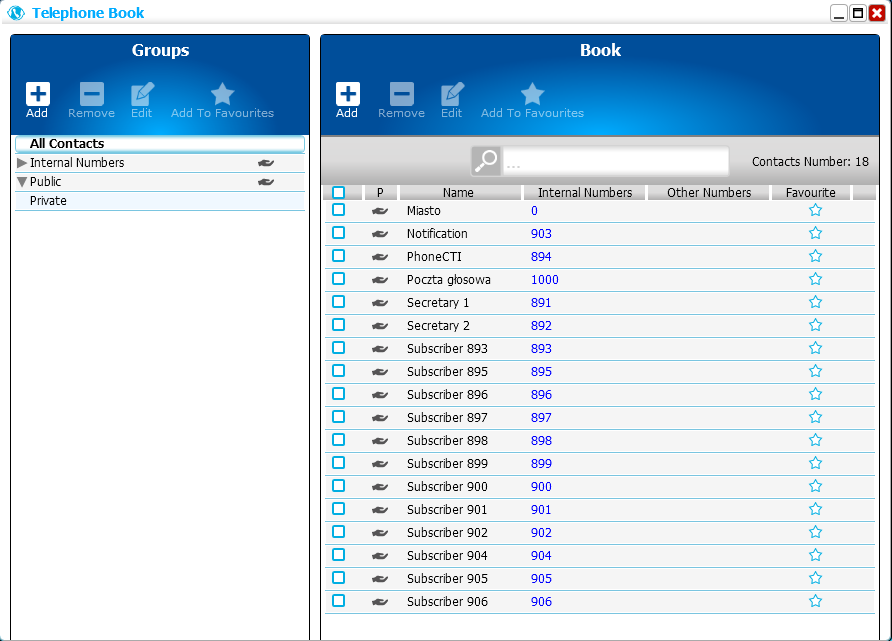
On the left side of above window you can see panel Groups, in this panel there is a list of groups which include numbers located in phone book as well as structure of these groups. PhoneCTI application user can add, edit and remove groups, however if he/she has no defined in PBX privileges to edit public phone book, all his/her actions concern only private phone book. To create new group, you should select group of higher level, where new created group should be located and click button Add. Following window will be visible on computer screen:

As a result of entering group number and its confirmation, new group will be added in appropriate place of left panel. After marking group and its selecting to edit, following window appears on screen:

In this window you can change name of created earlier group. Symilarly, after marking group and its selecting to remove following window appears on screen:

After confirmation, marked group will be removed. In the right panel, named Book, all contacts are visible. Contacts visible in this panel depend on marking in left panel. Among contacts are PBX extension numbers, numbers from public phone book and numbers entered by subscriber to private phone book. All contacts or only contact belonging to specified group are visible. Clicking button Add causes presenting following window on computer screen:
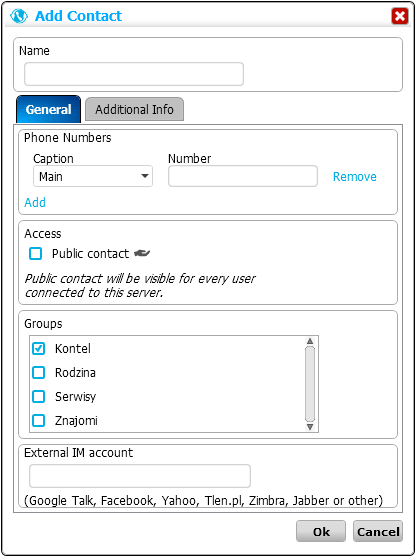
In this window, you can enter contact name, additionally for every contact it is possible to define many phone numbers (every phone number with appropriate comment). Wrong entered numbers can be removed. Additionally it is possible to contact to group - adding contact to group marked with icon , this icon means affiliation specified group to public phone book. Such situation take place, when PhoneCTI user has no privileges to edit public phone book.
Call history
After selecting tap History - history of calls with extension number assigned to PhoneCTI application is visible in the application main window. After selecting tap History, application main window presents as follows:
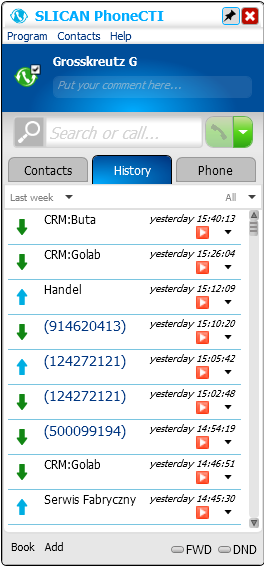
Every position of call history means one call incoming to or outgoing from number assigned to PhoneCTI application. Visible are all calls concerning this number and stored in PBX. For every position you can see the caller number, his/her comment (for outgoing calls it is dialed number and comment for this number if it exists in PBX), date and time of call. Beside text information, in every position there are some icons, which describe this call. There are:
This arrow means incoming call, which was answered.
This arrow means outgoing call, never mind if call was established or not.
This arrow means unanswered incoming call.
This icon means several unanswered incoming callsfrom the same caller, before review the call history. Number visible in this icon means quantity of such calls.
This icon means incoming call, answered by other subscriber. This icon can be used in two situations:
- call was routed to group including specified extension number and was answered by another group agent
- call was routed to specified subscriber but was picked up by another subscriber.
This icon means, that to specified numbe a SMS was sent, text of this SMS will be visible in window, which appears on screen after double clicking this position.
This icon means, that a chat was established with computer assigned to extension number visible in specified position. Text of this chat will be visible in window, which appears on screen after double clicking this position.
This icon means, that call was resorded.
Dialing
Dialing number from contact list
Dialing number from call history
Dialing number from application window
Call window
An example call window is presented in chapter 4.2.4 Settings - Calls. Appeariance of this window changes depending on context of window presentation. First of all - title of this window changes. Following situations are possible:
W środkowej części okna wyświetlane są trzy typy informacji:
- Komentarz przypisany do numeru telefonu dzwoniącego, wybieranego lub z którym rozmawiamy
|
- Numer tego telefonu
- Czas rozmowy, a przed zestawieniem połączenia - czas wywoływania
U dołu tego okna pojawią się przyciski umożliwiające podjęcie akcji, która będzie miała wpływ na zachowanie telefonu o numerze wewnętrznym, na który zalogowana jest aplikacja PhoneCTI.
Sending messages
Program PhoneCTI umożliwia przesyłanie wiadomości pomiędzy użytkownikami tego programu (podobnie jak znany program "Gadu-Gadu"), możliwe jest również wysyłanie wiadomości w postaci SMSów do osób, które posiadają telefony komórkowe. Zainicjowanie wysłania wiadomości następuje po kliknięciu prawym klawiszem myszki na dowolny kontakt z listy. Pojawi się wówczas poniższe menu kontekstowe:
Z powyższego menu wybieramy opcję Wyślij wiadomość lub Wyślij SMS'a, zależnie od tego czy chcemy wysłać wiadomość na numer wewnętrzny, czy inny. Po wybraniu odpowiedniej opcji pojawi nam się okno omówione w następnym akapicie. Powyższy tekst wskazuje na sposób wysłania wiadomości do innego użytkownika programu PhonCTI. Możliwe jest też odpowiadanie na przychodzące wiadomości. Omówiono to w następnym akapicie. Załóżmy, że inny użytkownik programu PhoneCTI wysłał do nas wiadomość.
Message window
Pojawienie się wiadomości jest sygnalizowane pojawieniem się w dolnym prawym rogu poniższego okienka:

Okienko to pojawi się jedynie wówczas, gdy zaznaczona zostanie odpowiednia opcja w ustawieniach (4.2.5 Ustawienia - Wiadomości) i zniknie po czasie również tam ustawionym, natomiast zawsze ikona programu trayu zacznie pojawiać się naprzemiennie z poniższą ikoną:
Kliknięcie w tę ikonę spowoduje wyświetlenie na ekranie komputera okna z wiadomością:

W oknie tym oprócz treści wiadomości wyświetlona jest także informacja o osobie, która tę wiadomość wysłała (wraz z jej opisem - jeżeli taki posiada) oraz godzina przesłania wiadomości. W dolnej części okna możliwe jest wpisanie treści odpowiedzi, którą chcemy wysłać. W górnej części okna znajduje się też przycisk umożliwiający zadzwonienie na numer abonenta, od którego otrzymaliśmy wiadomość. Kliknięcie lewej części klawisza spowoduje zestawienie połączenia z numerem, z którego otrzymaliśmy wiadomość, natomiast po kliknięciu w prawą część klawisza na ekranie ukaże się lista wszystkich numerów telefonów przypisanych do danego kontaktu. Z listy tej możemy wybrać numer, na który chcemy zadzwonić. Zestawienie połączenia odbywa się według standardowych zasad opisanych w rozdziale 4.2.2 Ustawienia - Ogólne.
Chat
Dzięki programowi PhoneCTI możemy prowadzić rozmowę z innym użytkownikiem programu, odpowiadając na jego wiadomości. Przykład takiej konwersacji pokazano na poniższym rysunku:
Wiadomości w zaprezentowanej powyżej formie są przechowywane do końca dnia. Następnie trafiają do archiwum i można je wyświetlić na ekranie po wybraniu odpowiedniej zakładki w Oknie wiadomości i określeniu dnia.
SMS
Wysłanie wiadomości w postaci SMS jest możliwe również do innych osób nie posiadających numeru wewnętrznego w centrali. Wysyłanie SMSa odbywa się poprzez bramkę GSM znajdującą się w centrali. Użytkownik chcący wysyłać wiadomości SMS musi posiadać uprawnienia do korzystania z TelefonCTI.plus. Wiadomość SMS jest wysyłana automatycznie przez centralę, a raport w postaci informacji o wysłaniu SMSa pojawia się w Oknie wiadomości:
Wysyłany SMS może mieć maksymalnie 160 znaków. Jeżeli jednak korzystamy z polskich znaków diakrytycznych ilość ta zmniejsza się do 70. Liczba znaków jakie pozostały do wpisania wyświetlana jest po prawej stronie okna. Program PhoneCTI uniemożliwi wpisanie większej niż dopuszczalna ilości znaków. W Oknie wiadomości znajduje się pole, którego zaznaczenie spowoduje, że wiadomość wysłana zostanie w postaci Flash SMSa.
Finding data
W programie PhoneCTI zastosowano stosunkowo zaawansowany sposób wyszukiwania tekstów. Wyszukiwania można dokonywać w każdym oknie programu, w którym pojawia się poniższe pole:
W miarę wprowadzania liter do powyższego okna, program PhoneCTI przeprowadza automatyczne wyszukiwanie. Odbywa się ono następująco:
- jeżeli liczba wprowadzonych znaków wynosi 1 lub 2, program wyszuka wszystkie łańcuchy tekstowe, w których dowolne ze słów zaczyna się od wprowadzonego tekstu,
- jeżeli liczba znaków wynosi 3 lub więcej, program wyszuka wszystkie łańcuchy, w których każde ze słów tego łańcucha zawiera wprowadzony tekst.
Jeżeli wyszukiwanie dotyczy kontaktów i odbywa się na liście kontaktów, a poszukiwany tekst nie zostanie znaleziony, program poinformuje o tym, zaproponuje nowego kontaktu i pokaże inne kontakty, które zawierają wprowadzony tekst i znajdują się poza aktualnym obszarem wyszukiwania. Działanie to ilustruje poglądowo poniższe okno:
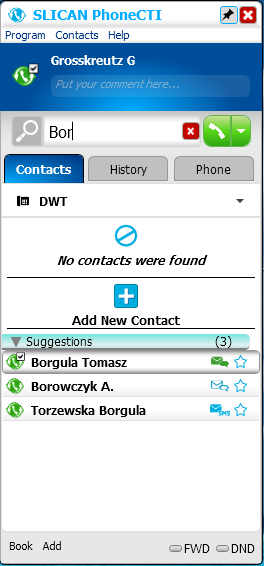
References
- ↑ In appliction settings, DND phone status can be forced, if application and phone remain in standby mode for sufficiently long time. This time can be defined in application settings
- ↑ This window appear on computer screen after double clicking on subscriber 1058 Instrukcja


